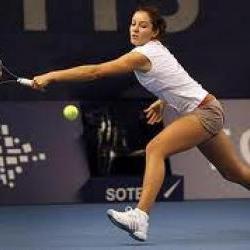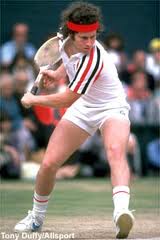Main Menu
Latest Blog Entry
User login
What are the Demands of Wimbledon Tennis?
Are you inspired by Wimbledon?
With Wimbledon starting today, we thought it would be good to to look at the requirements of tennis for all abilities and how aspiring players can improve. Duncan Buckmaster has done the research and here are his thoughts.

Physical demands of Tennis
Grand Slam tennis is a knockout tournament; matches are the best of 5 sets, to get to the final a player will have played 7 matches over 2 weeks.
A set is the first person to 6 games with a 2 game margin, the game will go to a tie break should it be 6-6 in games, unless in the last set when the players continue playing games until a two game lead is won.
in 2010 at Wimbledon the final set of a 1st round match went to 70-68 games, the match in its entirety lasted over 11 hours.
A game is scored 15, 30,40 then game or if 40-40 it goes to deuce and then advantage, this can continue until a two point lead is won.
Endurance demands of tennis
Tennis is a game of high intensity, short duration bouts requiring explosive reactive movements and shots with a variety of rest periods. There is a maximum rest of 20 seconds between points and 90 seconds between games and 2 minutes between sets which are set by the governing body.
There is some debate on which energy system is provides a foundation during a tennis match. Work done by Fox & Matthews (3) almost 40 years ago stated that 80% of work is done by the Adenosine Triphosphate (ATP) system, however, other research has suggested that the aerobic system is the primary aid to restoring ATP throughout a match.
Commonly we assume working on our aerobic capacity will always improve our athletes, these is normally done with longer less intense workouts. These theories are based on research that shows fatigue can reduce ball velocity and increase injury risk. (1)
However, research by Hoffman et al (2) has suggested there is a limit to which aerobic training aids improvements, Kovacs (1) suggests VO2 max of between 55-65ml-kg-1 are beneficial but above this further improvements are redundant.
Speed and Agility for Tennis
With video analysis now available several studies have been done on distances travelled during matches, this will depend on the level you play, the surface you are playing on.
Some stats that have been found over these studies:
- 80% of strokes played with less than 2.5m movement,
- 5% of stokes played require more than 4.5m movement,
- An average of 4 directional changes made during a point,
- Over 1000 directional changes made during a match,
- 70% of movements are lateral,
- 20% of movements are forwards,
- 8% of movements are backwards.
Flexibility & Mobility for Tennis
Due to the single sided nature, shots and surfaces; flexibility is a key area of concern among many tennis players. From young age many players will have solely played tennis which could mean they are one side dominant, they have not had a variety of sports to give their body a rounded education of movement.
From a young age we start to lose this flexibility due to the amount of time spent sitting at school/work or and then going home and sitting down all evening.
Being inflexible can have a knock on affect on other parts of the body due to how our bodies compensate for weakness. Three examples of how a lack of flexibility can affect
a tennis player:
- A tight pectoral (chest) muscle will pull the shoulder forward in posture; the muscle will be weaker due to its tightness, this will mean the body has to compensate to find power, which could mean the hips & back rotate more giving an inconsistent shot.
- A piriformis (a muscle deep inside the bum) in spasm (constantly tight) can cause pelvic immobility; which can mean the lower back muscles tighten, and the thoracic upper part of the back rounds more to create an illusion of mobility. This would mean that during a forehand shot the shoulder would need to find mobility and power putting the shoulder joint at risk of injury.
- A tight hamstring can result in a lack of knee stability, which could lead to injuries due to the lunging nature of tennis. The sciatic nerve which runs the length of the body could also be affected, so when you serve muscles will tighten to protect the nerve causing an inconsistent serve.
(Information on Common tennis injuries and how to prevent them here.)
Strength & Power for Tennis
Over the last 30 years the styles of play have changed from a flowing style to a more powerful style where player try’s to overpower their opponent. If we look at how modern players like Nadal compared to a player from 30 years ago John McEnroe, we can see a difference in musculature.


Power requires a good foundation of strength (4), this is so that the movement is controlled and consistent.
Part 2 on Wednesday: How to get fit for Tennis.
For a comprehensive training programme that fits into your schedule, try our Sports Training System
References:
1. Kovacs, MS (2006)
Applied Physiology of tennis performance. Brit. J. of sports Med. 40:381-386
2. Castagna, C, Manzi,
V, D’Ottavio, S, Annino, G, Padua, P, Bishop, D. (2007). Relation between
maximal aerobic power and the ability to repeat sprints in young basketball
players. J. Strength Cond. Res. 23:963-966
3. Fox, EL, Matthews,
DK. Interval training: Conditioning for sports and general fitness. Exercise
physiology: Theory application to fitness and performance (5th Ed.)
1974, P:426,2004
4. Asci, A, Acikada, C
(2007). Power production among different sports with similar maximum strength.
J. Strength Cond. Res. 21:10-16
Client Testimonials
James is an excellent and experienced Strength and Conditioning Coach. He is able to draw on these experiences to adapt and meet each client’s specific needs. James is known for his engaging and dynamic style that has proved effective in producing results. Having worked with James, he is both organized and efficient. He also is an evidence based practitioner happy to engage in debate and take on new ideas. James rightly demands high standards and a good work ethic which reflects his own contribution to each situation
More


Comments
[…] How fit you need to be to play tennis at Wimbledon, an overall look at what tennis fitness is about, How to get for tennis,specific ideas and […]